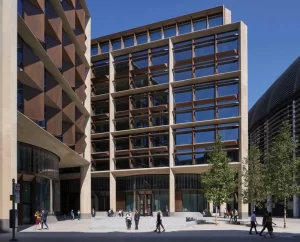The United Nations has written a set of “principles for sustainable and inclusive urban design and architecture” for architects to sign up to called the San Marino Declaration, which architect Norman Foster is set to launch.
Set to be ratified in the republic of San Marino next month, the declaration outlines a set of standards that architects and other built environment professionals should adhere to.
Declaration is Hippocratic oath for architects
“Next month I’m going going to be launching a United Nations declaration, which is the equivalent of the oath that physicians in ancient Greece undertook to uphold ethical standards,” Foster + Partners founder Foster told Dezeen, referencing the Hippocratic oath.
“In a way, it’s a condensation of the Sustainable Development Goals, which were also developed by the United Nations.”
Written by the Bureau of the Committee on Urban Development, Housing and Land Management, the San Marino Declaration will ask architects and other built environment professionals to agree to uphold a series of “principles for sustainable and inclusive urban design and architecture in support of sustainable, safe, healthy, socially inclusive, climate-neutral and circular homes, urban infrastructure and cities”.
Architects hold “key to a more sustainable future”
Signatories to the declaration would agree to design buildings and cities “in a way that limits the use of energy, uses only sustainable energy sources, reuses rainwater and limits the use of other natural resources”, as well as using recycled materials where possible.
The principles would also require architects to “respect the identity and cultural heritage of places and buildings”.
Originally focused on architects, Foster encouraged the writers to expand the reach to include all those involved in the built environment, who are described in the draft declaration as holding “the key to a more sustainable and inclusive urban future”.
“I’ve consciously encouraged the United Nations, who’ve grasped the idea that we should not just be inviting architects and engineers to sign up to this declaration,” said Foster.
“It should extend to city managers, politicians, developers, builders, everyone, everybody who’s involved, who is empowered to sign up to this declaration.”
At the launch, Foster will present several of his studio’s projects to demonstrate the ideals of the declaration. On an urban scale, these include its materplan for the city of Duisburg in Germany and Trafalgar Square in London.
He will also be showcasing the renovation of the Reichstag in Berlin “as a recycled building” and his firm’s Stirling Prize-winning Bloomberg HQ “as a new building”.
The United Nations is increasingly focusing on the built environment as a key sector that is causing climate change, alongside more well-known culprits like transport and energy.
The UN’s 26th annual climate conference COP26 addressed carbon emissions from buildings for the first time last November during a dedicated half-day, while the Intergovernmental Panel on Climate Change (IPCC) dedicated two entire chapters to buildings and cities in its most recent report.
While this makes architects and other built environment professionals crucial actors in the fight against climate change, the UK’s champion for COP26 told Dezeen last year that they are “one of the least well-represented businesses” in the UN’s net-zero push so far.
Below are the UN’s principles for sustainable and inclusive urban design and architecture:
People-centrality, social responsibility and inclusivity: urban planning, design and architecture need to foster and support social responsibility and integrate diversity and equality through due consideration of the needs of individuals and households across all races, age groups, gender, cultures, abilities and income levels, including intergenerational planning.
Cultural identity, values and heritage: urban planning, design and architecture should respect the identity and cultural heritage of places and buildings as well as the cultural values and traditions of communities.
Resource efficiency and circularity: every city, urban infrastructure and building should be designed in a way that limits the use of energy, uses only sustainable energy sources, reuses rainwater and limits the use of other natural resources and reduces resource losses.
In addition, every city, urban infrastructure and building should, to the extent possible, by design: use recycled materials; reuse and requalify spaces; reduce the production of waste reuse water; and encourage food production through urban agriculture, orchards and food forests.
Safety and health: every city, urban infrastructure and building should be based on internationally recognised quality standards as well as safety standards for workers and citizens, including fire safety.
Homes should provide a comfortable, safe and healthy living space, while cities and urban spaces should be designed with the imperatives of ensuring the safety and health of citizens; providing safe and sustainable mobility systems, including rail, road, inland waterways as well as walking and meeting spaces, green areas and urban forests that are accessible to all. Port cities need to ensure that port facilities are up to international transport and safety standards.
Respect for nature and natural systems and processes: every city, urban infrastructure and building should be designed in a way that limits its impact on the ecosystem of surrounding spaces, including by respecting plants, animals, and other organisms, as well as weather and natural habitats.
This implies conducting ex-ante environmental impact assessments, allowing spaces for biodiversity and using natural materials as well as low impact production assembling and dismantling processes.
Climate neutrality: cities, urban infrastructure and buildings should be designed and requalified to minimize the associated climate footprint, by adopting creative solutions that reduce pollution and energy use; phase out unsustainable mobility systems; use modern, energy-efficient, climate-neutral systems; and integrate green energy generation systems in city designs and buildings.
People-smartness: technology and smart information and communications technology solutions should be used to improve liveability, including the most socially disadvantaged, bolster transparency and curb corruption.
Resilience, durability, functionality and foresight: city and architectural design should support solutions that make homes, buildings and urban spaces resilient to natural disasters, especially those caused by climate change, including hurricanes, droughts and wildfires, flooding and high winds; and making buildings and infrastructures durable and flexible, incorporating spatial adaptability to accommodate new conditions and usages over time.
Affordability and accessibility: cities and homes need to be affordable and accessible to all citizens. Designers need to keep this factor in mind and design high-quality environments for meeting the needs of all citizens.
Inter-disciplinary cooperation and networking: cities and urban spaces should be designed to foster cohabitation, community engagement, solidarity and social cohesion taking into account the needs of citizens across all races, age groups, gender, cultures, abilities and income levels;
Engagement: consultation with and participation of the local communities is essential for any urban project, including small, medium and large-scale projects. Continuous engagement with various stakeholders, including longitudinal research, will foster trust, ensure responsiveness to the needs of all citizens, and consolidate shared ownership of the city’s future.



































